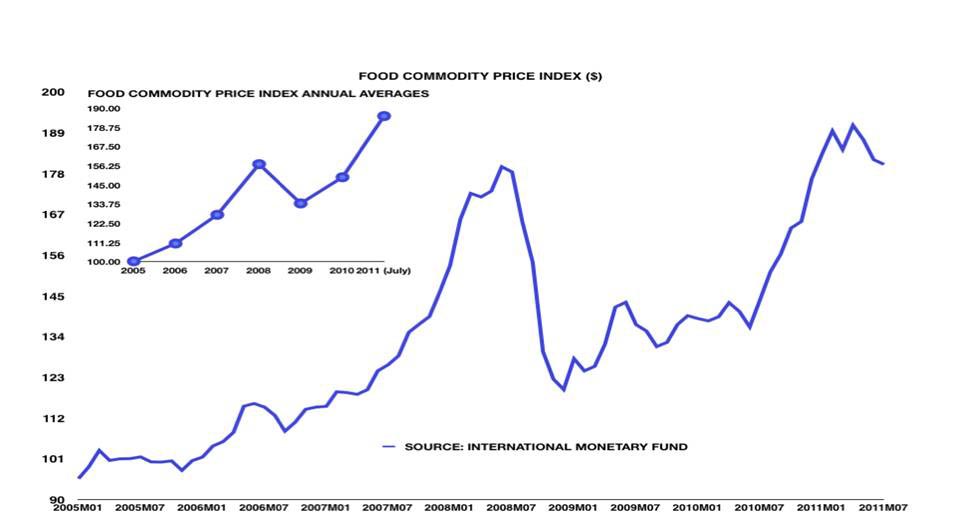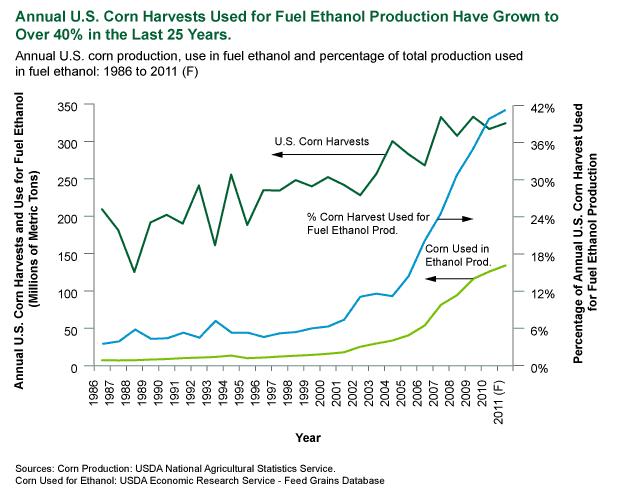| | Introduction | Chronology of events that affected food prices globally | What are the factors behind this recent rise in the relative food prices? | Implications of higher food prices | What is the Canadian situation? | Sources
,
Introduction

Many of us are feeling the same frustrations. In order to gain some insights to the food price inflation and its impact of Canadian consumers, in this short article, an attempt was made to analyze the situation in the global and local food markets.
Global food prices have increased significantly since early 2000s, reversing the long-term trend of declining relative food prices over previous decade.
Chronology of Events that Affected Food Prices Globally
- 2000 - US Congress exempts most over-the-counter derivatives contracts from government oversight; commodities trading soars.
- 2006 -US pass Brazil as world’s leading producer of ethanol
- 2007 -US Congress mandates a tripling in production of renewable biofuels by 2022.
- 2007-2008 - World food prices hit record high due- to rising energy costs, falling grain stocks. Food riots break out in 60 countries.
- 2010 - Arab Spring revolutions follow spikes in food prices. After worst drought in the century, Russia bans wheat exports……. Bread prices surge in Egypt, Russia’s largest wheat customer.
President Obama signs Dodd-Frank bill curbing speculation in commodities market.
- January 4, 2011 -Street vendor dies after setting himself on fire in protest, spurring revolution in Tunisia.
- January 25, 2011 -Street demonstrations spread to Egypt, partly in response to high food prices. Protests and demonstrations broke out throughout the Middle East.
- February, 2011 -World food prices hit all-time high and then decline slightly
- November 3-4, 2011 - G-20 nations met in Cannes, France; commodity speculations was on Agenda
What are the Factors Behind this Recent Rise in the Relative Food Prices?
Unfavourable weather conditions in number of key food producing countries.
 
Crop yield in the short-run can be significantly affected by temporary weather events such as droughts, floods or cyclones. Weather-related disturbances in a number of key food-producing countries have contributed to large price increases for a broad range of agricultural commodities over the past couple of years, most notably wheat, sugar, corn and oilseeds. However, it is important to note that these commodities are not homogeneous and price movements observed in local markets may vary because of differences in quality or barriers to trade such as tariffs as well.
Strong demand for agricultural commodities.

High population growth and rising living standards in developing economies are leading to an increase in protein consumption. This situation is contributing to broad-based pressure on food prices through demand on land use and demand for feed grains.
Strong demand for agricultural inputs into biofuel production

This has been identified as a factor behind the rise in the food prices. Record high oil prices increase the economic viability of this alternative energy source and encouraging farmers to shift planning towards biofuel feed stocks.
Implications of Higher Food Prices
- The rise in agricultural commodity prices has contributed to higher consumer price inflation in number of countries. Notably, higher food prices have placed upward pressure on inflation in several East Asian economies including China, South Korea and Indonesia.
- If food prices continue to rise, one concern is that consumers may come to expect higher inflation on an ongoing basis and adjust their behavior accordingly.
- The above is more likely to be an issue in developing countries where foods make up a larger share of households’ consumption basket.
- However, under unfavourable weather developments, a sharp, temporary rise in food prices should have no long term effect on inflationary expectations.
- At the end of year 2011 food price inflation is remaining relatively constrained.
Economic and Market analysis show that in the medium to long run, it is likely that food prices will remain at a relatively high level given on-going strong demand.
OECD and FAO (2010) projects that most crop and livestock prices over the next ten years (in real and nominal terms) will exceed the average level of the decade prior to the 2007/08 peaks.
Underpinning reasons are:
- An increasing high cost structure of agricultural production
- Strong demand from developing countries
- Continued expansion of biofuel production
- Slower growth in agricultural production
What is the Canadian Situation?
- According to Statistics Canada, Canada’s annual inflation rate remained stubbornly high during year 2011.
- Canadians continued to pay considerably more for food and gasoline. According to Statistics Canada, Consumers paid 4.8 per cent more for food in November, 2011 compared to a year earlier. This is the fastest increase since July 2009. Grocery prices were up 5.7 per cent and consumers saw double-digit increases for such basis as fresh vegetables and bread.
- Economists explain that this increases in prices stems from a lag effect. Increases in raw material prices typically take six to nine months to show up at the consumer price levels. Thus, high commodity prices from the spring may be playing a role in November’s price increases. However, studies have shown that the prices of raw agricultural commodities account for less than 10 in the final food products.
- Increasing food prices is also attributed to the increasing costs in long supply chain of food. A wide variety of inputs go into making finish food product such as transportation, packaging, advertising and the wages of workers as a product moves from farmers, to manufacturers, to wholesalers, and finally to retailers and restaurants.
- Economists are warning that after years of buying cheap food, Canadians have to pay higher prices for groceries. Now groceries are eating up greater share of their budgets amid price hikes for staples such as milk, bread and eggs. Normally consumers could simply substitute a cheaper food item for another. However, when staples are rising quickly cheaper substitutes may not be available.
- Some food producers are also dealing with higher prices. General Mills and some other leading food producers are reporting lower-than-expected quarterly profits in 2011.
- However, compared to the rest of the world, the high Canadian dollar, competitive pressure of retailer and adaptive behavior of consumer have helped to control the level of price inflation in Canada.
- Retail competition is a key reason for expected food price moderation in Canada. Wal-Mart Canada is opening new super centers in 2012, while Target is planning on entering the Canadian market in 2013. Both moves are expected to help slow food inflation and to put pressure on existing grocers: Loblaw, Sobeys and Metro to trim prices and maintain their market share.
- On the consumer side, Canadians are also responding to higher food prices. Price consciousness, value orientation and bargain –hunting will be common among consumers for years to come.
“ The bottom line is the food distribution landscape across the country in 2012
will likely change. It will probably become more competitive and put some pressure on food prices downwards”
Sources:
- Various News Websites/Articles: The Globe and Mail, The Wall Street Journal, BBC News, Euro monitor
- www.globalresearcher.com
- Rayner et al, Developments in Global Food Prices. Reserve Bank of Australia. Bulletin, March Quarter 2011.
- ww.bank-banque-canada.ca
Report in pdf version |
|